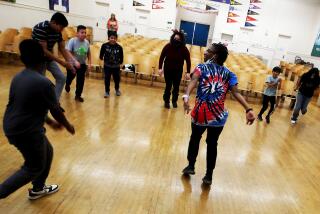Schools Freed to End Year-Round Schedules
- Share via
In a retreat from a controversial move three years ago that put all schools on year-round calendars, the Los Angeles Board of Education narrowly voted Monday to authorize parents, teachers and administrators at most schools to decide whether to return to a traditional September-to-June schedule.
The vote was a defeat for a move to scrap the year-round calendar in one stroke at many schools. It will not affect year-round schedules at many overcrowded inner-city campuses.
Citing a desire to share power with local schools, the board voted 4 to 2 to permit each of the Los Angeles school district’s 49 high school “complexes”--each consisting of a high school and its feeder elementary and junior high campuses--to choose their own schedules.
The complexes can opt to revert to the traditional calendar of years past or stay with the so-called common calendar, under which the school year begins in August, with long winter and summer breaks.
“The decision a couple years ago to move to a common calendar was made centrally after a lot of toil,” said Mark Slavkin, who introduced the local-option measure. “My goal is to accommodate the people at the local community level.”
But critics said the plan would throw the Los Angeles school system into disarray, forcing parents and school employees to cast hasty votes, and school district officials to scramble to revamp everything from busing patterns to the district’s spending commitments.
“This is going to be an entire mess. It’s going to be very confusing, and it confirms the image of the school board as not being able to figure anything out in a reasonable way,” said parent Diana Dixon-Davis of Chatsworth, who supported a competing motion by board member Julie Korenstein to return most of the district’s 650 campuses to a traditional schedule.
“We’ll take it,” she added, acknowledging that the board’s decision paves the way for her sons’ schools to resurrect the September-to-June calendar. “But there’s a lot better way.”
Monday’s narrow decision was the latest development in an emotional debate over year-round schools that has engulfed the district for nearly two decades. The current calendar was adopted in 1991 over the noisy objections of many parents. It was especially resisted in the San Fernando Valley and the Westside, where fewer schools are in need of the year-round calendar to help relieve overcrowding, one of its primary purposes.
Advocates of the current schedule contend that it is inequitable for schools in poor, densely packed neighborhoods to be forced to operate on a year-round schedule while students in more affluent, less crowded areas remain on a traditional calendar.
About 200 schools will have to remain on the year-round calendar to create space for their students, who attend class on staggered schedules throughout the year. Those “multitrack” campuses serve nearly half of the district’s 641,000 youngsters, mostly in racial minority neighborhoods.
“We’re not talking about choice” for those schools, board member Jeff Horton said, because those school complexes will not be given authority to change their calendars. “Equity is not an issue I can so lightly dismiss.”
Nonetheless, Horton voted for the measure, bowing to the complaints of mostly San Fernando Valley parents whose children must attend class in sweltering August heat. After last year’s reapportionment of school board boundaries, Horton--who previously represented only a district in the central city--represents much of Van Nuys in the Valley.
“If this is a question of equity, I suggest you turn the heaters on over the hill and heat those classrooms to 105 degrees,” said Jill Reiss of Northridge, a mother of two students who was one of about 20 speakers to address the board. Nearly all were from the Valley and spoke in favor of a traditional calendar.
“If this is a question of race, I invite you to come and see that the 73% of students in the Valley who are students of color sweat, faint and get bloody noses just like the Anglos,” she said.
Board members Slavkin, Horton, Leticia Quezada and Roberta Weintraub voted for Slavkin’s proposal. Members Barbara Boudreaux and Warren Furutani voted no, while Korenstein abstained.
School officials have just two months to implement the measure, which requires the district to define the high school complexes--since many grade and junior high schools feed into more than one high school--notify parents and campus personnel, institute a voting process and rework the routes of some of the district’s 2,100 buses, depending on how many schools opt to scrap the year-round schedule.
Gordon Wohlers, head of the office that supervises scheduling, said his staff is suggesting a Sept. 7 start date for schools that revert to the traditional calendar. That calendar would scale back the current eight-week winter recess to two weeks, reinstitute a one-week spring break and resurrect the three-month summer vacation.
Additionally, depending on how many of the 400 non-multitrack schools choose to return to the traditional schedule, the district could recoup some or all of the $4.2 million it costs each year to implement the common calendar.
More to Read
Sign up for Essential California
The most important California stories and recommendations in your inbox every morning.
You may occasionally receive promotional content from the Los Angeles Times.











